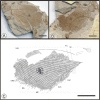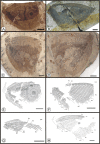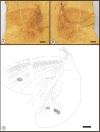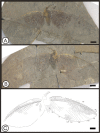Mesozoic lacewings from China provide phylogenetic insight into evolution of the Kalligrammatidae (Neuroptera)
- PMID: 24912379
- PMCID: PMC4113026
- DOI: 10.1186/1471-2148-14-126
Mesozoic lacewings from China provide phylogenetic insight into evolution of the Kalligrammatidae (Neuroptera)
Abstract
Background: The Kalligrammatidae are distinctive, large, conspicuous, lacewings found in Eurasia from the Middle Jurassic to mid Early Cretaceous. Because of incomplete and often inadequate fossil preservation, an absence of detailed morphology, unclear relationships, and unknown evolutionary trends, the Kalligrammatidae are poorly understood.
Results: We describe three new subfamilies, four new genera, twelve new species and four unassigned species from the late Middle Jurassic Jiulongshan and mid Early Cretaceous Yixian Formations of China. These kalligrammatid taxa exhibit diverse morphological characters, such as mandibulate mouthparts in one major clade and siphonate mouthparts in the remaining four major clades, the presence or absence of a variety of distinctive wing markings such as stripes, wing spots and eyespots, as well as multiple major wing shapes. Based on phylogenetic analyses, the Kalligrammatidae are divided into five principal clades: Kalligrammatinae Handlirsch, 1906, Kallihemerobiinae Ren & Engel, 2008, Meioneurinae subfam. nov., Oregrammatinae subfam. nov. and Sophogrammatinae subfam. nov., each of which is accorded subfamily-level status. Our results show significant morphological and evolutionary differentiation of the Kalligrammatidae family during a 40 million-year-interval of the mid Mesozoic.
Conclusion: A new phylogeny and classification of five subfamilies and their constituent genera is proposed for the Kalligrammatidae. These diverse, yet highly specialized taxa from northeastern China suggest that eastern Eurasia likely was an important diversification center for the Kalligrammatidae. Kalligrammatids possess an extraordinary morphological breadth and panoply of adaptations during the mid-Mesozoic that highlight our conclusion that their evolutionary biology is much more complex than heretofore realized.
Figures



















References
-
- Grimaldi D, Engel MS. Evolution of the insects. New York: Cambridge University Press; 2005. pp. 335–351.
-
- Aspöck U, Aspöck H. Phylogenetic relevance of the genital sclerites of Neuropterida (Insecta: Holometabola) Syst Entomol. 2008;33:97–127. doi: 10.1111/j.1365-3113.2007.00396.x. - DOI
-
- Carpenter EM. In: Treatise on Invertebrate Paleontology Arthropoda 4. Moore RC, Kaesler RL, editor. Kansas: Geological Society of America, and University of Kansas Press; 1992. Superclass Hexapoda; pp. 338–356.
-
- Handlirsch A. Die fossilen Insekten und die Phylogenie der rezenten Formen. Ein Handbuch für Paläontologen und Zoologen. Leipzig: W. Engelmann; 1906–1908. pp. 1–1430.
-
- Handlirsch A. Eine neue Kalligrammide (Neuroptera) aus dem Solnhofen Plattenkalke. Senkenbergiana, Frankfurt am Main. 1919;1:61–63.
Publication types
MeSH terms
LinkOut - more resources
Full Text Sources
Other Literature Sources

